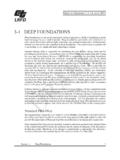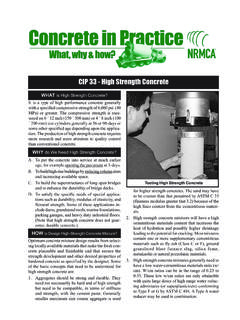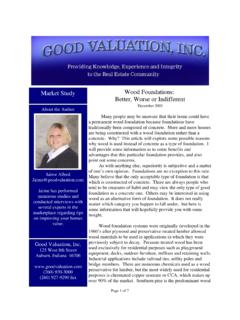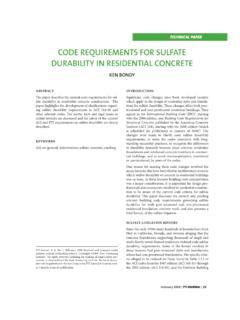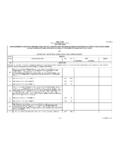Transcription of Leaflet 6 - Foundations - Final Nary 26 01 07
1 HOW TO DESIGN. concrete . STRUCTURES. Foundations Instructions for the Members of BIBM, CEMBUREAU, EFCA and ERMCO: It is the responsibility of the Members (national associations) of BIBM, CEMBUREAU, EFCA and ERMCO. to translate and/or adapt this publication within their national framework, to publish it under their own name and to disseminate it to their contacts at national level. Copyright: Name of National Member Acknowledgements to the European concrete Platform EMBARGO: 31 March 2007. The Members of BIBM, CEMBUREAU EFCA and ERMCO are not allowed to publish this brochure before 31 March 2007. Copyright: European concrete Platform (when legal body is established), March 2007. All rights reserved. No part of this publication may be reproduced, stored in a retrieval system or transmitted in any form or by any means, electronic, mechanical, photocopying, recording or otherwise, without the prior written permission of the European concrete Platform: BIBM (International Bureau for Precast concrete ).
2 CEMBUREAU, The European Cement Association; EFCA (European Federation of concrete Admixtures Associations); ERMCO (European Ready Mixed concrete Organisation). Published by the European concrete Platform Editor: Jean-Pierre Jacobs 8 rue Volta 1050 Brussels Layout & Printing by The European concrete Platform All information in this document is deemed to be accurate by the European concrete Platform at the time of going into press. It is given in good faith. Information on European concrete Platform document does not create any liability for BIBM, CEMBUREAU, EFCA and ERMCO. While the goal is to keep this information timely and accurate, the European concrete Platform cannot guarantee either. If errors are brought to its attention, they will be corrected.
3 The opinions reflected in this document are those of the authors and BIBM, CEMBUREAU, EFCA and ERMCO. cannot be held liable for any view expressed therein. All advice or information from the European concrete Platform is intended for those who will evaluate the significance and limitations of its contents and take responsibility for its use and application. No liability (including for negligence) for any loss resulting from such advice or information is accepted. Readers should note that all European concrete Platform publications are subject to revision from time to time and therefore ensure that they are in possession of the latest version. How to design concrete structures using Eurocode 2. 6. Foundations Eurocode 7: Geotechnical design Introduction This should be redrafted in each Scope country as appropriate All Foundations should be designed so that the soil safely resists the actions applied to the structure.
4 The design of any foundation consists of two components; the geotechnical design and the structural design of the foundation itself. However, for some Foundations ( flexible rafts) the effect of the interaction between the soil and structure may be critical and must also be considered. Geotechnical design is covered by Eurocode 71. There are two parts to Eurocode 7, Part 1: General rules and Part 2: Ground investigation and testing. The essential features of Eurocode 7, Part 1 relating to foundation design are discussed in this guide. It should be emphasised that this publication covers only the design of simple Foundations , which are a small part of the scope of Eurocoe 7. Therefore it should not be relied on for general guidance on this Eurocode.
5 Limit states The following ultimate limit states (ULS) should be satisfied for geotechnical design; they each have their own combinations of actions. (For an explanation of Eurocode terminology refer to How to design concrete structures using Eurocode 2: Introduction to Eurocodes2). EQU Loss of equilibrium of the structure. STR Internal failure or excessive deformation of the structure or structural member. GEO Failure due to excessive deformation of the ground. UPL Loss equilibrium due to uplift by water pressure. HYD Failure caused by hydraulic gradients. In addition, the serviceability limit states (SLS) should be satisfied. It will usually be clear that one of the limit states will govern the design and therefore it will not be necessary to carry out checks for all of them, although it is considered good practice to record that they have all been considered.
6 Geotechnical categories Eurocode 7 recommends three geotechnical categories' to assist in establishing the geotechnical design requirements for a structure (see Table 1). Methods of design and combinations values for the partial factors to be applied to the actions There has not been a consensus amongst for these combinations of partial factors are given in geotechnical engineers over the application of limit Table 2 and the partial factors for the geotechnical state principles to geotechnical design. Therefore, to material properties are given in Table 3. Combination 1. allow for these differences of opinion, Eurocode 7 will generally govern the structural resistance, and provides for three design approaches' to be used for combination 2 will generally govern the sizing of the the ULS.
7 The decision on which approach to use for a Foundations . The partial factors for soil resistance to particular country is given in its National Annex. Design sliding and bearing should be taken as for both approach 1(excluding pile and anchorage design) is combinations. illustrated in this guide. In this approach, there are two sets of combinations to use for the STR and GEO The partial factors to be applied to the actions at the ultimate limit states. The EQU limit state are given in Table 4; the geotechnical material partial factors being the same as for combination 2 in Table 3. For the SLS, Eurocode 7 does not give any advice on whether the characteristic, frequent or quasi- permanent combination should be used. Where the prescriptive method is used for spread Foundations (see page 3) then the characteristic value should be adopted.
8 For direct methods of calculation the frequent Spread Foundations combination can be used for sizing of Foundations and The geotechnical design of spread Foundations ( the quasi-permanent combination can be used for strip and pad Foundations ) is covered by section 6 of settlement calculations. Eurocode 7, Part 1 and this gives three methods for design: Further information on design combinations can be Direct method calculation is carried out for each found in another guide in the series, Introduction to 2 limit state. Eurocodes . Indirect method experience and testing used to determine serviceability limit state parameters that Geotechnical design report also satisfy all relevant limit states (included in A geotechnical design report should be produced for Eurocode 7 mainly to suit French design methods, each project, even if it is only a single sheet.)
9 The report and is not discussed further here). should contain details of the site, interpretation of the Prescriptive method in which a presumed bearing ground investigation report, geotechnical design resistance is used. recommendations and advice on supervision, monitoring and maintenance of the works. It is likely For most spread Foundations , settlement will be the that this report will require input from more than one governing criterion; traditionally allowable bearing consultant, depending on whether the project is in pressures' have been used to limit settlement. The geotechnical category 1, 2 or 3. concept of increasing the factor of safety on bearing resistances to control settlement may still be used with The foundation design recommendations should the prescriptive method.
10 The exception is for soft clays include bearing resistances and characteristic values where Eurocode 7 requires settlement calculations to be for soil parameters. It should also clearly state whether undertaken. the values are applicable to SLS or ULS and whether they are for combination 1 or combination 2. When using the direct method, calculations are carried out for each limit state. At the ULS, the bearing resistance of the soil should be checked using partial factors on the soil properties as well as on the actions. At the SLS the settlement of the Foundations should be calculated and checked against permissible limits. The prescriptive method may be used where calculation of the soil properties is not possible or necessary and can be used provided that conservative rules of design are used.

